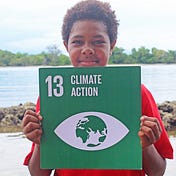Leave No-one Behind: Why Disability Inclusion Matters
Dr Arunee Limmanee, the Advisor on Education and Employment, the Association of the Physically Handicapped of Thailand
Asia-Pacific, the world’s most disaster-prone region, is home to 650 million persons with disabilities. Persons with disabilities are four times more likely to die in disasters. Based on their specific needs, both regular and special support should be provided.
Unfortunately, the support they get is often not responsive to their needs due to the lack of participation by persons with disabilities in the process of disaster risk reduction (DRR) planning. In some cases, individuals with disabilities are even excluded from emergency drills or other disaster preparedness activities.
Even though Thailand has ratified the Convention on the Rights of Persons with Disabilities (CRPD) which mentions Disability-Inclusive Disaster Risk Reduction in Article 11, full participation of persons with disabilities has not been widely practiced.
The government, private agencies and Civil Society Organizations (CSOs) are making efforts to solve this issue. Awareness raising campaigns and DRR programmes have been launched in schools and local communities. Disaster preparedness plans have been made with participation of stakeholders including persons with disabilities and disabled people’s organizations (DPOs) as they are the ones who can best identify their own needs.
Full participation of individuals with disabilities requires creating an environment that can be accessed, understood and used by all persons regardless of their age, size, ability or disability. Known as Universal Design, this concept is not about special requirements but about universal right to have access to information, transportation etc. during a disaster or emergency situation.
Simply put, the early warning system and information disseminated during emergencies must be accessible and understandable by all groups of persons, including persons with sensory disabilities (deaf, blind and deaf-blind), intellectual, mental or behavioral disabilities, or age-related restrictions.
Transportation is also very important for evacuation of persons with disabilities or serious health conditions. When making an evacuation plan, we have to identify how persons with disabilities can get to the safe areas: on foot, by van, by cars or other means of transportation; and who will assist them during the evacuation.Some groups such as women and girls with disabilities may have additional needs. Dignity kits should be adequately provided for them.
For example, the local government agencies can get information from DPOs in the community and work closely with them in planning DRR management. The local administrative offices such as Sub-district Administrative Offices (known as “or bor tor” in Thai) and Provincial Administrative Offices (known as “or bor jor” in Thai) play important roles in DRR at the community level as they have information about disabled individuals living in their province. These local offices work with schools, hospitals and representative organizations of persons with disabilities in the community to create a support network in their communities.
At the national level, the Department of the Empowerment of Persons with Disabilities is the focal point of disability work in the country, and the Department of Disaster Prevention and Mitigation is focal point for DRR management. These two government agencies are key players in disaster risk reduction for persons with disabilities. They cooperate with each other in disaster preparedness and management.
How all these parties can come together for all-inclusive disaster preparedness, was presented during the tsunami drills in Phang Nga province in Thailand, supported by the United Nations Development Programme (UNDP) and the Government of Japan. The drills ensured that all students participated in the drills and the evacuation routes were wheelchair accessible for students with physical disabilities. The older students were trained to help younger ones, and the teachers were coached to assist students with disabilities. The support from the communities, local disaster management authorities and international organizations like the Red Cross made sure that no-one was left behind.
Originally published at medium.com on July 3, 2018.





